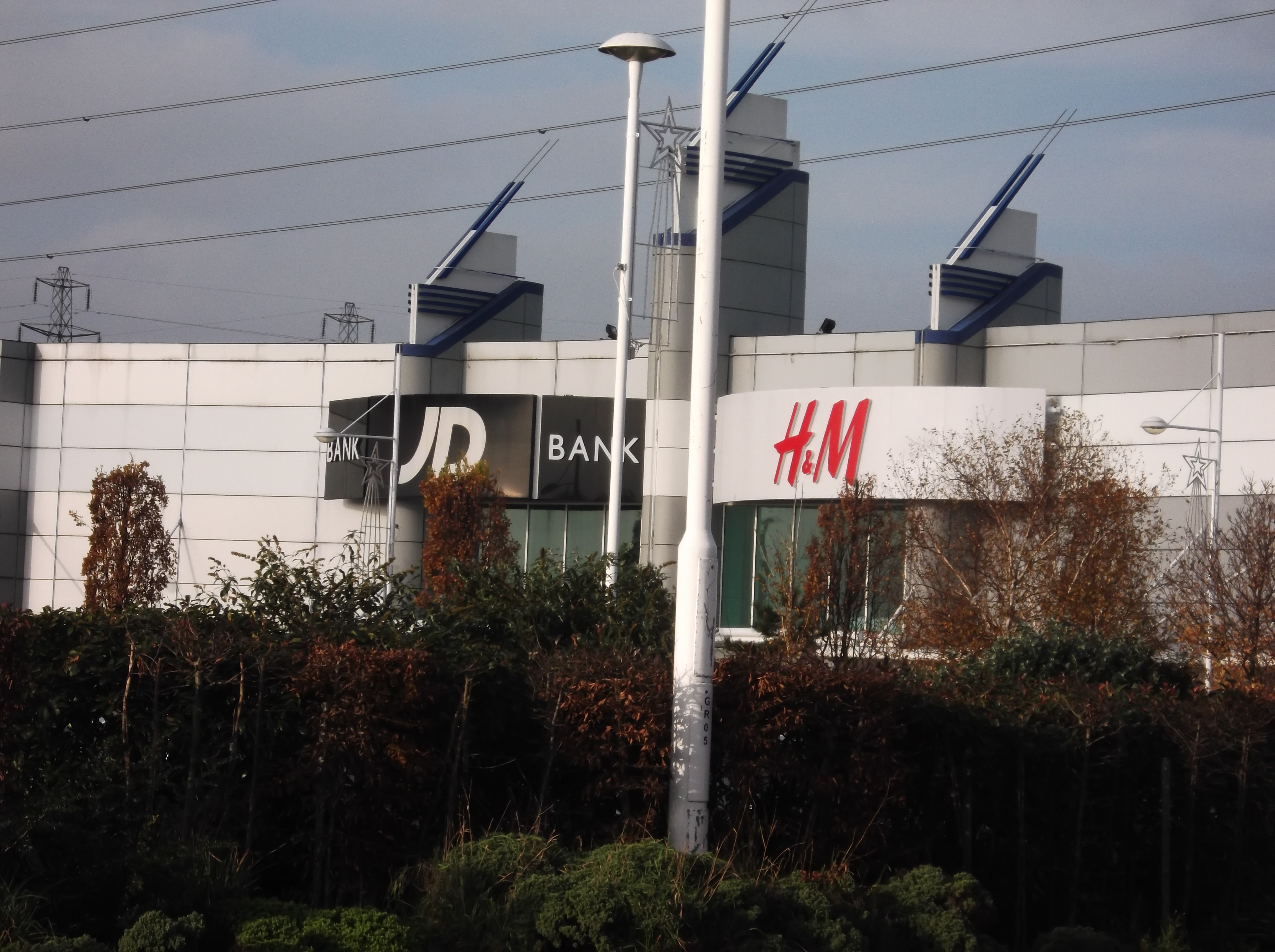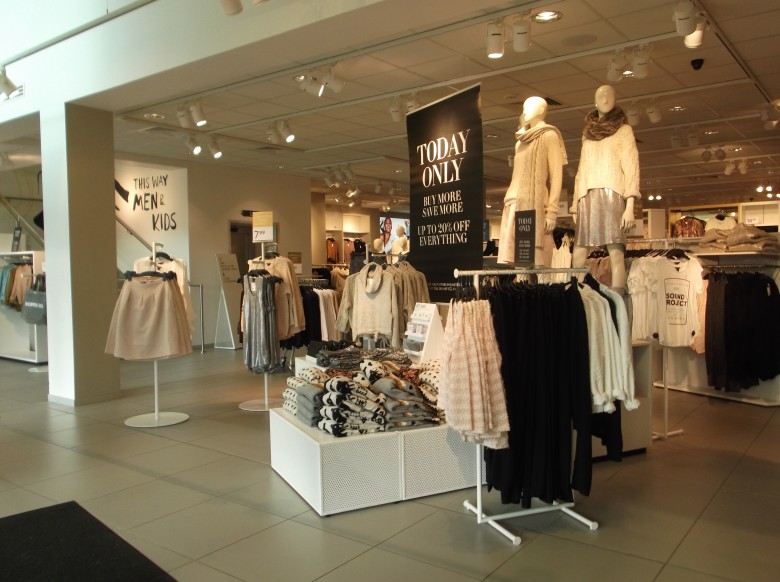
03 Dec Sustainable fashion a trend to stay?
Sustainable fashion has been a vast growing trend in the fashion industry and is becoming a well-established practice amongst major fashion designers and retail chains alike, writes Sabrina Shafi
An Autumn/Winter clothing display at an H&M store. Photograph: Sabrina Shafi
Sustainable fashion, ten years ago for instance, would have most likely been defined or associated as eco-fashion that is predominately hemp based or would have been considered to be a somewhat ‘hippyish’ trend. But times have of course changed and at present sustainable fashion has been a driving force in the fashion industry in raising awareness of the environmental impacts of producing clothing garments, in a much more fashion forward approach. The trend in sustainable fashion continues to flourish amongst the fashion industry.
The most recent London Fashion week was a prime example of how the trend in sustainable fashion is playing a significant role in the fashion industry. London fashion week had showcased a range of sustainable fashion collections where by designers such as Ekaterina Kukhareva, Felder Felder, Ed Marler, Julia Korol as well as many others had shown examples of recycling and repurposing and using locally sourced materials throughout their collections. Sustainability in fashion has been rapidly increasing in popularity for many years now. Since last year there have been many sustainable fashion designers producing immaculate clothing garments some of whom include the likes of Stella McCartney, Veja, Blue Q, People Tree and ASOS Green Room to name a few.
The arrival of “H&M’s Conscious Range – Don’t Let Fashion Go To Waste” has also played a huge role in raising awareness of sustainability in fashion amongst consumers and in the retail market. Karl-Johan Persson, CEO of H&M explains the aims of the sustainable fashion initiative at H&M on the H&M website: “At H&M, we have set ourselves the challenge of ultimately making fashion sustainable and sustainability fashionable. We want to help people express their personality and feel proud of what they wear. I’m very excited to see the progress we’ve made so far and how this will help us to make you an even better offer – and create a more sustainable fashion future”. H&M had first launched their sustainable fashion range to the high street in April 2012. The year that followed saw the launch of their Conscious Party Wear collection in spring and most recently in October of this year H&M have launched their new Conscious Denim collection.
Consumers have become more aware of sustainability amongst the fashion industry and the ways in which they can shop as well as be conscious of the environmental and social impacts when shopping.
When speaking to consumer Taslima Begum, who is a regular shopper at H&M, about her experience of shopping sustainably on the high street she said: “I know that H&M are currently doing a recycling scheme eco initiative. I actually used it a couple of weeks ago. They give you a bag when you go into the shop and you fill up that bag with old clothes they recycle it for you or donate it and you get a five-pound voucher in return. It’s quiet good.
In terms of consumer awareness when asking Miss Begum whether she believed that clothing retail companies were promoting sustainable fashion efficiently she said: “I think that some are and some aren’t and I believe that some aren’t even trying. H&M are one of the shops that I think are doing quiet good. They have a conscious collection that is promoting sustainable products also shops like ZARA and Victoria Secret have pledged to detox their production practices.”
Since 2010 the sustainable fashion movement has been on the rise. The pioneering brands that were amongst the first to lead the way in sustainable fashion were Stella McCartney and Noir. Most recently in August of this year fashion brands Stella McCartney, H&M, Zara as well as Quicksilver pledged to end sourcing fibres from endangered forests. The pledge was taken into effect after discussions emerged from Canopy, a Not-for-profit organsation that had estimated millions of trees in endangered forests were being ‘cut, chipped and then treated with a chemical concoction to break them down into pulp slurry’. Since August of this year Stella McCartney has pledged that all cellulose fibres in her collections will meet “strict sustainability standards” by 2017, H&M have developed a three-year plan to end all sourcing from the world’s endangered forests and Quicksilver have announced and have “committed to using reasonable efforts to influence our own fabric supply chain.”
At present there is a huge array of fashion exhibitions, blogs as well as other platforms that are specifically focused on sustainable fashion. Some current sustainable organisations that have blogs showcasing sustainable fashion include, The Centre for Sustainable Fashion, Not Just a Label, Ethical Fashion Blog, Ecouterre and Ecoluxe London.
The rise of blogs and social networking sites has played a significant role in promoting ethical fashion to consumers and raising further awareness of the environmental and social impacts. Not Just a Label is the world’s leading designer platform for showcasing and nurturing ‘today’s pioneers in contemporary fashion’. Robert Cavell-Clarke, Head of Scouting & Designer Relations at Not Just a Label mentions of ways in which the organisation encourages designers to produce fashion sustainably and the overall objective of the platform.
“Our main objective is to support young designers and help them flourish in their own countries and internationally but by embracing sustainable methods.
“Because it saves them money and helps them so it’s the core of what we do but it’s also trying to change it because in some cases ethical fashion is sometimes seen as a gimik and you get big companies where they might do one range of say 200 sustainable t-shirts that are ethical and they are organic cotton and they are sustainable but if that company also makes 700 thousand tons of non ethical and non sustainable garments it doesn’t make sense.
Due to the recent increase of awareness in sustainable fashion by well known fashion brands Clarke discusses the business value behind sustainable fashion at NJAL, he says: “We always talk about sustainability but its not always on the side of its good for the environment its also good for business as well. And I think that’s good. There’s nothing wrong with saying ‘I am sustainable and I am ethical but the main reason why I do it is because it saves me money’ because it does. So I think it’s not just about the gimik of being sustainable it actually helps your business. So that’s what we continue and teach to our designers.” Clarke also mentions of the sustainable fashion market’s increasing market value at present, he says: ”I think sustainability is a by product of good business. A good business should be run in an ethical and sustainable way. And that’s just a positive by product of your business.”
In relation to the ethical fashion market overall sustainability has come to be closely associated with luxury goods. An example of this is Ecoluxe London, which is a not-for-profit organisation of which ‘promotes and supports ecological and sustainable luxury fashion’. The organisation alongside promoting sustainable fashion also showcases the work of fashion brands based in or expanding to the UK as well as UK based manufacturers and they carry this out biannually during London Fashion Week. Stamo who is the director of the organization explains the luxury market and its relationship with sustainability, she says: “There is huge potential because if you look at it from the business side the sustainable market in the luxury side is really small so there is a huge potential. And that’s the reason companies like Gucci are trying to make sustainable products. It’s a very good marketing effort and it’s a very good marketing exercise.”
In relation to the overall trend seen in the sustainable fashion market Clarke on the trend of sustainability at present, says: “I think it has been used as a trend but there is a revolution that is building in terms of sustainability and a lot of companies are doing and taking it a lot more seriously now. And its not just about clothes its about the companies that make the washing machines, wash at only 30 degrees Celsius and other things. It’s about the tech companies who are building machines that can print knitted jumpers in one go. This is proper stuff.”
So what can we expect to see for the future in sustainable fashion?
Well, currently there have been discussions of ways to maintain sustainability in the fashion industry. According to Samata Angel who is a global campaign director at the Red Carpet Green Dress, in her article on sustainable fashion being design-led she discusses that sustainable initiatives should be predominately design led in order to be successful amongst consumers and states that ‘the simple truth is that image is all-important in the world of fashion’. As we have discussed, this is already occurring and is on the rise with designers combing both design as well as sustainability to produce exceptional fashion garments for consumers. In terms of where the sustainable fashion market is heading Stamo expresses her view of sustainable fashion: “I think it’s heading to become a big trend if it manages to hold. Being a big trend it might translate into being a way of life.”


